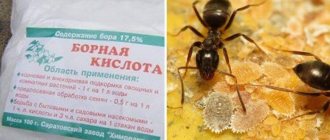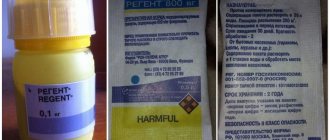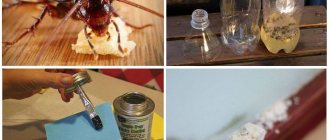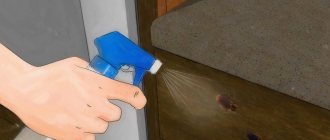Boric acid is a substance that is used in medicine, cosmetology and as an insecticide to kill insects. For treatment, it is used externally in pure or diluted form. If a poison based on this substance is accidentally ingested, which often happens with domestic animals, boric acid poisoning occurs. If you suspect that a toxin has entered the gastrointestinal tract, you should immediately consult a doctor or veterinarian.
Silver nitrate poisoning - lapis
Manifestation of poisoning : the mucous membrane of the dog’s oral cavity becomes gray or white;
the dog sits hunched over and groans; there is vomiting of white masses, which then darken; diarrhea, black stool; there may be seizures. Help : give the dog table salt, prepared at the rate of 1/2 teaspoon of salt per 1 liter of water; You can add small pieces of ice to the saline solution; milk is given abundantly; A milk enema is given.
Efficiency and disadvantages
Although many people use boric acid to prepare poisonous solutions and other “treats” for cockroaches, it is most effective to kill them with the product in powder form. And it's very easy to do.
The substance is scattered in those parts of the apartment where insects live or where they can run:
- surfaces near baseboards;
- under kitchen cabinets and cabinets;
- under the sink or next to the bathtub.
The shell is especially attractive to cockroaches . There is something here that they cannot live without - water.
As soon as the parasite runs over the powder with boric acid, the product remains on its paws, then it enters the insect’s body and gradually leads to death. By the way, such products as Dohlox and Regent work on the same principle.
Among the advantages of this tool, it is worth noting its availability and cost-effectiveness. A sachet weighing 10 grams is enough to destroy thousands of parasites. Although, in practice, more poison is often consumed, since it often goes unnoticed by parasites.
Unlike special crayons, traps and gels, only those Prussians who were in direct contact with the powder can be poisoned. The powder is not poured in large heaps, but in modest portions, as if they were spilling flour or sugar. Otherwise, cockroaches will avoid the poison. Among the obvious disadvantages, it can be noted that using boric acid is useless to fight cockroach eggs .
To get rid of eggs, more effective methods are needed, such as Get liquid concentrates.
Cockroaches are excellent opportunists, despite the fact that they enter homes in different ways and not all species can fly, all “Stasiks” without exception masterfully adapt to any conditions and reproduce very quickly, with a high survival rate.
The use of this product in the fight against ants is very effective.
Poisoning with aniline (chemical pencil)
Manifestation of poisoning : the dog begins to vomit; the animal is lethargic; the skin and mucous membranes are initially pale, then gray-blue; pupils are dilated, breathing is difficult; the temperature drops; urination is difficult, there is often blood in the urine; in severe cases of poisoning - convulsions.
First aid : it is necessary to take the dog out into the fresh air; give strong cold tea and milk inside; Place an ice pack or cold compress on your head.
Mustard poisoning
Manifestation of poisoning : redness forms on the skin, the animal loses vision - severe conjunctivitis; when licking dry mustard from the fur - salivation, vomiting, diarrhea, shortness of breath, trembling.
First aid : if possible, shake off the mustard powder from the animal’s fur, if impossible, wash it off with neutral oils (olive, sunflower, Vaseline); If mustard gets inside the dog, give it a mucous decoction to drink and give it activated charcoal.
Poisoning with poisonous mushrooms
Manifestation of poisoning : the dog feels sick, vomits, groans due to abdominal pain, diarrhea is usually bloody; increased thirst; body temperature drops to 36°; the pulse is slow and barely detectable; consciousness in severe conditions is unclear; The dog does not recognize the owner and does not respond to the name.
First aid : rinse the stomach with water or a pale pink solution of potassium permanganate; give the animal activated carbon, drink strong tea, coffee, then inside - castor oil from 1 teaspoon to 100 grams, depending on the breed; if the animal is excited, then put a cold compress, a heating pad with cold water or an ice pack on the head.
Is it dangerous to use boric acid in an apartment?
Boric acid, as a remedy for cockroaches, is fatal only for them and some other small insects, such as ants. It poses no threat to people or pets. Previously, boric acid was even used as an antiseptic when treating wounds.
Absolute safety is one of the most important reasons why you should try this particular method to combat cockroaches. If you have small children or animals at home, the use of special, more powerful poisons can pose a serious danger.
But, there are situations when boric acid does not help and you have to resort to stronger means. Read about how to get rid of cockroaches in other ways in our next article .
Cockroaches are the oldest insects that still plague humans, although on a smaller scale than twenty years ago. Despite their slightly smaller number in houses and apartments, people are still concerned about questions: how dangerous are these insects, can they bite?
To combat them, our stores offer a wide range of products. These are aerosols and sprays, gels and insect powders.
But along with them, long-known folk remedies continue to be popular. And among them is boric acid, as the main ingredient of poisonous mixtures.
While insect repellent manufacturing companies come up with new formulas and invent all kinds of repellers and aquafumigators, grandmothers use proven methods. And the younger generation in many cases trusts their experience.
Poisoning with carbolic acid (creolin, lysol, etc.)
Poisoning often occurs when bathing animals with the addition of drugs based on carbolic acid in order to combat skin parasites.
Manifestation of poisoning : at high concentrations of the solution, blisters, ulcers, and eczematous rashes form on the dog’s body; if a toxic substance gets inside - vomiting, constriction of the pupils, decline in cardiac activity, drop in body temperature.
Necessary help : for skin lesions - apply compresses with neutral oils (vegetable, olive, vaseline); if the poison gets inside, give the dog burnt magnesia, water with pieces of ice, egg white, activated carbon, mucous decoction, Glauber's salt (10 g of salt per 200 g of water); keep the dog warm.
Consequences and prevention
Intoxication with boric acid can lead to the development of negative consequences.
We recommend: Chloroform poisoning - symptoms in adults and children
What happens:
- Inflammatory processes in the liver and kidneys,
- Malfunctions of the cardiac system,
- Development of a comatose state,
- Death.
A favorable prognosis does not guarantee the absence of pathological processes in the kidneys. You can avoid poisoning by following simple prevention measures.
Rules:
- Do not store the substance in accessible places,
- Be careful when using a chemical compound
- It is not recommended to use the product to control insects in a home with animals.
- The substance should not be used for self-medication.
An overdose of boric acid can give a person a lot of unpleasant sensations. Without help, death is possible. If signs appear, you need to quickly contact a medical facility.
Potassium permanganate poisoning
Manifestation of poisoning : if there has been external use of strong solutions, for example wiping the oral cavity, swelling of the oral mucosa and larynx is observed.
Necessary assistance : in case of burn of mucous membranes, treat the burn site with weak solutions of hydrogen peroxide; if a very strong solution of potassium permanganate gets inside, you need to give the dog activated charcoal, milk, egg white; if cardiac activity declines, give the animal cordiamine (2-20 drops, depending on the dog’s weight).
Boric acid with egg - recipe for cockroaches
Egg balls with boric acid are one of the most common recipes.
For this recipe you will need:
- egg yolk;
- 50 grams of boric acid.
If necessary, you can increase the number of baits, the main thing is to adhere to the correct proportion of eggs and boric acid.
Mix these ingredients thoroughly, roll them into small balls, and then place them in hard-to-reach places.
Boric acid with an egg against cockroaches is a fairly simple and affordable recipe. By analogy with this recipe, you can make balls with flour and any other products. Either way, the food will attract the cockroach and it will swallow the bait.
Mothball poisoning
Manifestation of poisoning : increased thirst, vomiting; the animal is trembling, excited; possible diarrhea; in severe cases, cyanosis of the mucous membranes, involuntary urination and stool discharge are observed; there may be blood in the urine.
Required help : drink plenty of water with a solution of potassium permanganate (pale pink solution of potassium permanganate) or activated carbon, then a saline laxative. It is strictly forbidden to give fats and food containing them to your dog.
First aid and treatment of intoxication
If signs of poisoning appear, it is necessary to quickly provide the victim with the necessary first aid.
What to do:
- First of all, in case of poisoning, call a doctor,
- If boric acid gets on the mucous membranes or skin, rinse with cool water.
- It is necessary to cleanse the stomach of toxic substances. Rinse with water. The procedure is repeated until the boric acid is completely released. It is prohibited to use potassium permanganate solution for rinsing to avoid burns to the esophagus.
- It is not recommended to stop spontaneous vomiting or diarrhea in case of poisoning; the body independently tries to get rid of toxins.
- It is not recommended to use sorbents; they will not help in such a situation due to the fact that boric acid does not come into contact with these medications.
- The use of saline laxatives is acceptable.
- Taking special medications or drinking large amounts of water will help you avoid dehydration.
- The patient is kept at rest and transferred to doctors for further treatment.
We recommend: Pesticide poisoning
Intoxication therapy continues in a medical facility. The necessary diagnostics are carried out and suitable methods of therapy are selected.
Treatment methods:
- Cleansing the stomach using a probe,
- Using saline laxatives
- Blood transfusion,
- Hemodialysis,
- Forced diuresis,
- Administration of intravenous medicinal solutions,
- In case of serious poisoning, it is possible to administer plasma,
- If necessary, resuscitation measures are carried out.
There is no specific antidote to boric acid.
Fern poisoning
Poisoning by fern (its preparations) occurs when: inept use of medications to expel worms.
Manifestations of poisoning : salivation, vomiting, bloody diarrhea, respiratory failure, fever.
Necessary help : inside - activated carbon, mucous decoctions; place the animal in a darkened room; Milk and other foods containing fats are strictly prohibited from being given to the affected dog.
Food poisoning occurs in dogs as a result of eating foods containing toxic substances of bacterial and non-bacterial origin.
Manifestation of poisoning : thirst, vomiting, diarrhea, increased body temperature to 39.7-40°.
Necessary help : give the dog activated charcoal, a pale pink solution of potassium permanganate, then laxatives and medications that disinfect the intestines; give a cleansing enema.
Cat poisoning. Symptoms, treatment
Poisoning in cats can be caused by poisons (substances that have a negative effect on the body).
Thanks to its hunting instincts, the mammal often explores the contents of garbage dumps, landfills, hunts small game (birds, moles, mice, rats, toads, frogs, insects), sometimes eating carrion, which leads to intoxication.
The manifestation of signs depends on the type of poison, the route of entry into the body, the amount of the toxic substance, the time of exposure and the general condition of the animal.
Any ailment should not be ignored. If you suspect that your cat has been poisoned, immediately call a veterinarian for emergency assistance and further treatment.
The main signs of poison entering the body:
- excessive salivation
- vomit
- diarrhea
- hallucinations
- convulsions
- loss of consciousness
- coma
Poisonous plants
To cleanse the stomach, many animals eat plants to induce vomiting and rid themselves of hairballs. But his intuition does not always tell him that the plant is poisonous, and eating various parts ultimately causes intoxication.
Some are toxic only to the stems, others to the leaves, and still others to all parts. A huge variety of wild and domestic plants pose a threat to a cat’s life, and it is not always possible to determine exactly what she has eaten.
General symptoms of intoxication:
- irritation of the oral mucosa
- salivation
- vomit
- diarrhea
- hallucinations
Houseplants can cause a variety of damage, sometimes fatal.
Many contain oxalic acid, which causes burns to the mucous membranes. In this case, the following are observed: swelling of the oral cavity, loss of coordination, and collapse often develops.
Poisonous flowers cause vomiting, abdominal pain, and cramps. Some of them cause tremors (trembling) of the limbs, heart/pulmonary failure, and impaired renal function, which often leads to death.
When eating indoor plants, it is easier for the owner to determine what exactly poisoned the pet, which greatly facilitates the provision of first aid.
There are also many plantings on the street that are poisonous to the mammal.
Cat poisoning with chemicals
A mammal can be poisoned not only by food, carrion, plants, but also by chemicals.
When grooming itself, the animal licks its fur and paw pads, which may contain poison.
Many chemicals enter the body through inhalation of vapors, which also causes poisoning (varnish, paint, gasoline, disinfectants).
Antifreeze (ethylene glycol)
The substance has a sweet taste, which is very attractive to cats. A teaspoon is enough to cause severe poisoning.
In this case, the following are observed:
- unsteady gait
- growing weakness
- vomit
- stupor
- seizures (rare)
- coma
It is necessary to induce vomiting and immediately show the pet to a veterinarian. In the absence of qualified assistance, death occurs within 24 hours.
If the animal survives the acute phase, kidney failure subsequently develops, which in turn can lead to death.
Petroleum products
Inhaling vapors from volatile liquids (gasoline, kerosene, turpentine) or getting them into the respiratory tract can cause pneumonia.
Symptoms of poisoning:
- vomit
- labored breathing
- trembling in the limbs
- muscle twitching
- coma
With the development of acute respiratory failure, death is possible.
It is strictly forbidden to induce vomiting! It is necessary to give water, sweet fruit drinks, soda (0.5 g per 0.5 kg of cat’s weight).
Take the injured pet to the vet immediately.
Acid and alkali
Irritating substances are found in household chemicals and technical solvents.
Consumption leads to burns of the mucous membranes. Possible narrowing or rupture of the esophagus and stomach.
If acid gets into your cat's mouth, rinse the mucous membranes with water or soda. Give your pet some vegetable oil.
Pest control products
If there are cockroaches, mice and other inhabitants at home, the four-legged pet can easily be poisoned by the bait left in order to destroy unwanted “neighbors”.
The baits have an attractive smell, which will definitely provoke you to taste it. The most severe poisonings are caused by toxic substances intended to combat insects (insecticides), small rodents and snails (rodenticides).
Other substances
Nicotine contained in cigarettes can cause intoxication (nicotine smoke poisoning). Animals also like some cosmetics containing “appetizing” odors.
Four-legged animals can chew a piece of soap, eat cream from a poorly closed tube, or steal lipstick. In this case, it will not lead to severe poisoning, but will cause gastrointestinal upset.
Drug poisoning of a cat
Even if you are at home, your pet can also get poisoned. One of the main reasons is medicines carelessly left by the owner in an accessible place.
A pet can eat its owner's tablets or veterinary medications containing special additives that change the smell and taste, which arouses the animals' interest.
If you are sure that the cat has eaten the tablets, immediately induce vomiting. After cleansing the stomach, give a coating agent (butter, raw egg white, milk), call an emergency veterinarian.
Food poisoning
But even if you carefully hide all medications from your pet, there remains a high risk of poisoning. The reason for this may be food from a person’s table (chocolate, salt, spices, smoked meats).
Felines are sensitive to food poisoning, so they immediately develop symptoms of poisoning.
The animal has:
- pain syndrome in the epigastric region
- vomit
- loose stools (sometimes with blood)
The addition of a bacterial infection leads to the development of shock and death.
If the poisoning was minor, recovery occurs in 1-2 days. An examination and consultation with a specialist is required.
Poisoning by poisonous gases
A rare type of intoxication is gas intoxication. A pan left on the stove can cause a gas leak when the boiling contents splash onto the stove and extinguish the fire.
Flammable gas is dangerous to all living beings. Carbon monoxide produced during fires is also deadly.
Cats that are transported in the trunk of a car may develop symptoms of carbon monoxide poisoning (exhaust fumes). At first, the symptoms may not be noticeable, but with physical exertion, when the need for oxygen increases, the animal may collapse.
In this case, the following are observed: incoordination, convulsions, coma. Possible death.
What to do if your cat is poisoned?
It is necessary to determine the degree of loss of consciousness and vital signs: breathing and heartbeat.
If the cat is unconscious, the oral cavity should be examined to avoid vomit getting into the respiratory tract and tongue retraction.
You should pull your tongue out and clear the oral cavity of the contents. The animal must be laid on a flat, hard surface so that the hind limbs are higher and the head is lower than the body.
The cat should be covered with a warm towel and a veterinarian should be called to your home immediately. If there are no signs of life, begin artificial respiration and chest compressions.
Be careful to avoid such situations.
Lead poisoning (lead lotion water)
Manifestation of poisoning : thirst, whitish coloration of the mucous membranes of the oral cavity; vomiting whitish-gray masses; diarrhea.; the stool is initially black, then bloody; heavy breathing; the pulse is pronounced; moaning due to abdominal pain; convulsions are possible.
Help needed : if possible; rinse the stomach; Give the dog plenty of milk, strong tea, coffee, give it egg whites, a solution of baking soda (1 teaspoon of soda per 1 liter of water).
Symptoms of intoxication
When poisoning with boric acid, external signs appear that indicate intoxication. Laboratory tests are used to identify its cause.
- Dyspeptic disorders. Vomiting, diarrhea mixed with blood, constant nausea, acute abdominal pain.
- Symptoms of illness. Fatigue, lethargy, decreased appetite, drowsiness.
- A characteristic symptom is changes in the skin. A rash, itching, peeling, burning, and redness appears.
- Neuralgia. Convulsions, seizures, muscle tremors.
- Decreased or absent urine output. This indicates kidney failure, which develops due to exposure to a toxic substance and a decrease in the amount of fluid due to vomiting and diarrhea.
- Edema due to impaired renal function.
Poisoning with sleeping pills
Manifestation of poisoning : a state of drowsiness, turning into deep sleep; pallor of the mucous membranes, slow breathing, weak and rare pulse; the temperature drops; the skin, mucous membranes of the mouth and eyes are pale; breathing is slow and shallow; the pulse is barely palpable, rare; in severe cases, the mucous membranes and tongue turn blue, and the dog falls into an unconscious state.
Necessary help : if possible, rinse the dog’s stomach and give him any laxative, strong tea, coffee (cold), warm the animal, give medicine - 5-30 drops of cordiamine (depending on the breed of the dog).
Solanine poisoning (greened or sprouted potatoes)
Manifestation of poisoning : vomiting, diarrhea; the animal sits hunched over or lies down, groans; breathing is heavy, pulse is uneven - arrhythmic.
Required assistance : gastric lavage, laxatives, enemas, cordiamine drops (5-30 drops, depending on the breed of dog); cold strong tea, coffee. To prevent such poisoning, animals should not eat green or sprouted potatoes. Potatoes should be stored out of reach of dogs.
How to poison cockroaches with boric acid?
Boric acid can be purchased at many pharmacies, both in powder form and as a solution. The powder is most often packaged in 10 gram bags, so to fully combat cockroaches you will need several bags.
The affordable price of boric acid is one of the decisive factors in choosing this product. But it is not always able to completely solve the problem. The fact is that killing cockroaches with boric acid takes a lot of time, and besides, insects begin to adapt to this poison. If there are already a lot of cockroaches in the house, it is better to use stronger products.
In order to properly poison cockroaches with boric acid, it is better to first understand the principle of its action. Once in the body of a cockroach, boric acid acts on the nervous system of the insect, causing paralysis of all nerves and muscles and, as a result, death.
In order for the cockroach to receive a sufficient amount of poison, it must swallow it.
The product works most effectively under the following conditions:
- For a lethal result, a cockroach must ingest a dose of about 2-3 mg of boric acid;
- It is better to use boron powder rather than an alcohol solution, since the latter will repel insects with its odor.
- It is necessary to block the cockroach's access to water, since after drinking enough liquid, it can survive.
Boric acid is odorless and tasteless. To poison cockroaches with boric acid, you can use several methods:
- Use boron powder itself;
- Make edible baits based on boric acid;
- Leave liquid baits with diluted boric acid for the cockroaches.
With the first method, it is necessary to scatter small paths of boric acid near the habitats of cockroaches: near the baseboard, sink, toilet, in dark corners of the room. Most often, cockroaches live in the kitchen, so if you go there at night, you can track where exactly they will run. In those places you need to spread boron powder.
Running through the boron path, the cockroach will grab a small amount of this product with its paws, after a while it will begin to clean them and eat the poison.
Boric acid against cockroaches is a recipe for control that does not require large financial costs and effort. It can be added to any food or water, after which these baits can be left overnight.
To effectively use liquid bait against cockroaches, you need to dilute boron powder in water and leave a saucer with this liquid on the sink, after drying the surface around it. Then the cockroach will have no choice but to drink the poisoned liquid.
There are many recipes for edible baits against cockroaches:
- Egg balls with boric acid;
- Flour baits;
- Baits with potatoes, etc.











